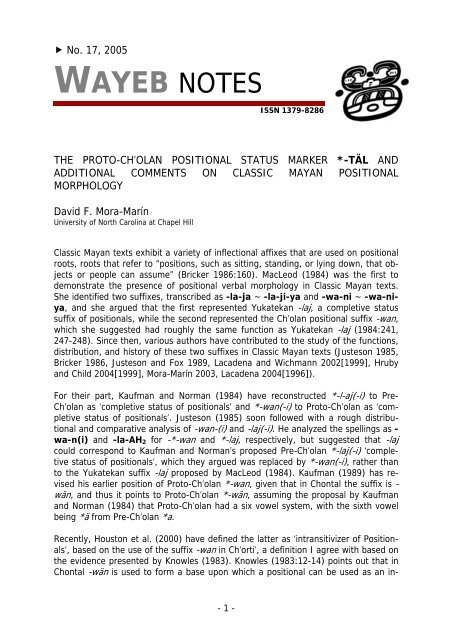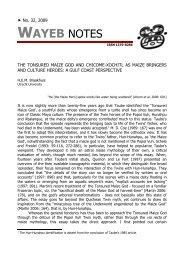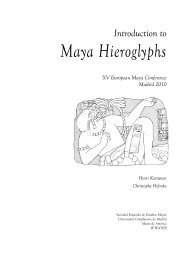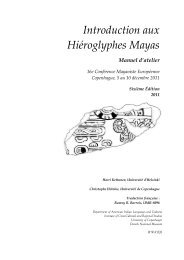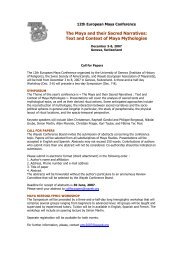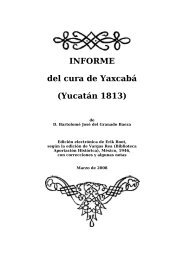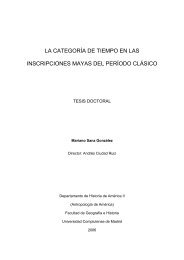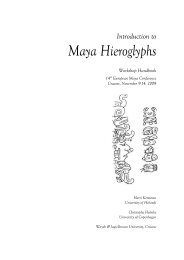The Proto-Ch'olan Positional Status Marker - Wayeb
The Proto-Ch'olan Positional Status Marker - Wayeb
The Proto-Ch'olan Positional Status Marker - Wayeb
Create successful ePaper yourself
Turn your PDF publications into a flip-book with our unique Google optimized e-Paper software.
transitive with any status suffix (e.g. -i ‘completive status of intransitives’, -el ‘incompletivestatus of intransitives’): chum-wän-el-on sit-POS.IVZR-INC.ST-1sABS ‘I amseated’, 7a ch’on-wän-Ø-on CMP.ASP squat-POS.IVZR-CMP.ST-1sABS ‘I squatted’.Given that the same is true for Ch’orti’, as illustrated by Pérez Martínez (1994:77, 79)with forms like wa’-wan stand-POS.IVZR for ‘se paró (s/he stood (up))’ and ‘pararse(to stand)’, and given that Ch’ol does not preserve productive uses of this suffix, itseems unproblematic to suggest that <strong>Proto</strong>-Ch’olan *-wän was an ‘intransitivizer ofpositional roots’.Given this evidence, and the likelihood that the spelling -la-ja ~ -la-ji-ya correspondsto Pre-Ch’olan *-l-aj(-i), I favor a redefinition of this latter suffix as well, as *-l-aj ‘intransitivizer of positionals’. <strong>The</strong> -i ‘completive status of intransitives’ providedthe sense of completion on its own when added to *-l-aj, which can be analyzed as -(V 1 )l-aj. Houston et al. (2000:332) have suggested that the l of -l-aj originated in thestative suffix -V 1 l, a suggestion I agree with here. Kaufman and Norman (1984:106)reconstruct the “lexical stem” of positional verbs in <strong>Proto</strong>-Ch’olan-Tzeltalan (the sameas <strong>Proto</strong>-Greater Tzeltalan) as *CVC-l, but do not discuss the origin of the -l stemformingsuffix, which I take to be based on -V 1 l. <strong>The</strong> second part of -l-aj, Houston etal. (2000:333) have argued, is originally the second morpheme of the bipartite affix*-h-…-aj ‘intransitivizer of positionals’, which they reconstruct to the common ancestorof Ch’olan and Tzeltalan languages. Given that *-l-aj presumably was also an ‘intransitivizerof positionals’, given that it was replaced by *-wän ‘intransitivizer ofpositionals’, it is possible that the -aj suffix was simply originally based on *-aj ‘genericintransitivizer’, also reconstructed by Kaufman and Norman (1984:107, 109,Table 14) to <strong>Proto</strong>-Ch’olan-Tzeltalan and <strong>Proto</strong>-Ch’olan, though this is just a tentativehypothesis that requires detailed testing which I do not provide here.Interestingly, additional positional suffixes have been identified, such as the -V 1 l ‘stative’suffix, attested in spellings like CHUM-mu-l(i) for chum-ul sit-STA ‘sitted’, asseen in Figure 1. Another example is the -l-ib’ ‘instrumentalizer of positionals’ suffix,attested in spellings like ’e-k(e)-li-b’(i) for (h)ek-l-ib’ (Wichmann 2002). Thus,there are already four well attested suffixes of positional verbs.Figure 1: Example of CHUM[mu]-lifor chum-ul sit-STA ‘seated’ fromCopan Hieroglyphic Stair Step 8(Schele 1989:81). Drawing by B. W.Fash<strong>The</strong>re is yet another suffix of positional verbs attested in Classic Mayan texts. Onvase K2784 shows a secondary text (Figure 2a) where one finds the spelling ti-CHUM[mu]-ta-li (Figure 2b) following the collocation *’u-B’AH for u-b’ah(-il) ‘(itis) his face/portrait’.-2-
Figure 2: a) Secondary text on vaseK2784, A1-C7. b) Glyphs C2-C3 on samesecondary text: ti-CHUM[mu]-ta-li, tichum-täl PREP sit-INC ‘sitting’. Detail ofphotograph of vase K2784 in Reents-Budet (1994:94).This ti-CHUM[mu]-ta-li expression isundoubtedly an example of a ticonstruction(Josserand et al. 1985), andinterestingly one that attests to a suffix -tal or -täl. Kaufman and Normanab(1984:107) reconstruct <strong>Proto</strong>-Ch’olan *-tälas ‘non-stative incompletive status of positionals’.Given that the expression alludes to a portrayed lord shown in a seated posturean expression ti chum-täl PREP sit-INC ‘sitting’ makes perfect sense. <strong>The</strong> tichum-täl phrase is followed by the name of the person who is ‘a-sitt-ing’. In otherwords, the suffix -täl clearly is used here as a ‘nominalizer’, as one would expect inthe context of the ti-construction; and given that the <strong>Proto</strong>-Ch’olan nominalizing suffixused with transitive and intransitive stems in this construction was *-el (Mora-Marín 2004), also the ‘incompletive status of intransitives’, was originally a ‘nominalizer’,it makes sense that -täl would be used as a ‘nominalizer’ in the same context,given that it also was the ‘(non-stative) incompletive status of positionals’. In otherwords both -el and -täl may have started out as ‘nominalizers’, the former of transitiveand intransitive roots, the latter of positional roots, and were subsequently extendedto incompletive status marker.Also interestingly, Stuart (2005:73) has recently provided a similar example onlyshowing ti-CHUM[mu]-li instead of ti-CHUM[mu]-ta-li, as seen in Figure 3.Figure 3: Example of ti-CHUM-mulifor ti chum-ul ‘seated’. Drawing byDavid Stuart in Stuart (2005:73).Thus, the suffix attested in this second example is the stative suffix -V 1 l. This identificationthen adds one more to the attested positional suffixes: -laj, -wän, -V 1 l, -l-ib’,and -täl.-3-
References CitedBricker, Victoia R.1986 A Grammar of Mayan Hieroglyphs. Middle American Research Institute Publication56. New Orleans: Tulane University.Houston, S. D., J. Robertson, and D. S. Stuart. 2000. <strong>The</strong> Language of Classic MayaInscriptions. Current Anthropology 41:321-356.Hruby, Zachary X., and Mark B. Child2004 Chontal Linguistic Influence in Ancient Maya Writing. In <strong>The</strong> Linguistics ofMaya Writing, edited by Søren Wichmann, pp. 13-26. Salt Lake City: <strong>The</strong> Universityof Utah Press.Justeson, John S.1985 Hieroglyphic Evidence for Lowland Mayan Linguistic History. InternationalJournal of American Linguistics 51:469-471.Justeson, John S., and James A. Fox1989 Hieroglyphic evidence for the languages of the Lowland Maya. Unpublished MSin possession of author.Josserand, Kathryn, Linda Schele, and Nicholas A. Hopkins1985 Auxiliary Verb + ti Constructions in the Classic Maya Inscriptions. In FourthPalenque Round Table, 1980, Volume VI, edited by E. P. Benson, pp. 87-102.San Francisco: Center for Pre-Columbian Art Research.Kaufman, Terrence1989 Mayan Comparative Studies, Parts A-D. Unpublished manuscript used withpermission of author.Kaufman, Terrence, and William Norman1984 An outline of proto-Cholan phonology, morphology, and vocabulary. In Phoneticismin Maya Hieroglyphic Writing, edited by J. S. Justeson and L. Campbell,pp. 77-166. Institute for Mesoamerican Studies Publication No. 9. Albany: StateUniversity of New York.Knowles, Susan M.1983 Chontal Mayan <strong>Positional</strong>s. Journal of Mayan Linguistics 4(2):7-34.Lacadena, Alfonso2004 Passive Voice in Classic Maya Texts. In <strong>The</strong> Linguistics of Maya Writing, editedby Søren Wichmann, pp. 165-194. Salt Lake City: <strong>The</strong> University of UtahPress.-4-
Lacadena, Alfonso, and Søren Wichmann.2002 <strong>The</strong> Distribution of Lowland Maya Languages in the Classic Period. In La organizaciónsocial entre los mayas; memoria de la Tercera Mesa Redonda dePalenque, vol. II, edited by Vera Tiesler Blos, Rafael Cobos and Merle GreeneRobertson, pp. 275-319. México, D.F.: Instituto Nacional de Antropología eHistoria, and Mérida: Universidad Autónoma de Yucatán.MacLeod, Barbara1984 Cholan and Yucatecan Verb Morphology and glyphic verbal affixes in the inscriptions.In Phoneticism in Maya Hieroglyphic Writing, edited by J. S. Justesonand L. Campbell, pp. 233-262. Institute for Mesoamerican Studies PublicationNo. 9. Albany: State University of New York.Mora-Marín, David F.2003 Pre-Ch’olan as the Standard Language of Classic Lowland Mayan Texts. Paperpresented at the 2002-2003 SSILA Meeting, Atlanta, Georgia, January, 2003.[Unpublished manuscript available for download at www.unc.edu/~davidmm]2004 Pre-<strong>Proto</strong>-Ch’olan as the Standard Language of Classic Lowland Mayan Texts.[Unpublished manuscript available for download at www.unc.edu/~davidmm]Pérez Martínez, Vitalino1994 Gramática del Idioma Ch’orti’. La Antigua, Guatemala: Proyecto LingüísticoFrancisco Marroquín.Reents-Budet, Dorie1994 Painting the Maya Universe: Royal Ceramics of the Classic Period. Durham:Duke University Press.Schele, Linda1989 Notebook for the XIIIth Maya Hieroglyphic Workshop at Texas. Austin: ArtDepartment, University of Texas at Austin.Stuart, David2005 Sourcebook for the 29 th Maya Hieroglyphic Forum. Austin: Art Department,University of Texas at Austin.-5-


